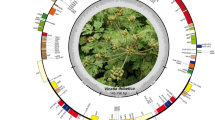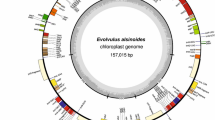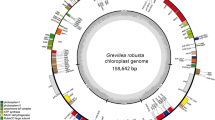Abstract
Cissus quadrangularis L., a member of the Vitaceae family, is an important medicinal plant with widespread application in Indian traditional medicines. C. quadrangularis L. whole chloroplast genome of 160,404 bp was assembled using a genome skimming approach from the whole genome library. The assembled chloroplast genome contained a large single-copy region (88,987 bp), a small single-copy region (18,621 bp), and pairs of inverted repeat regions (26,398 bp). It also comprised 133 genes, including 37 tRNAs, eight rRNAs, and 88 protein-coding genes. Aside from that, we annotated three genes atpH, petB, and psbL, as well as one duplicated copy of the ycf1 gene in C. quadrangularis L. that had previously been missing from the annotation of compared Cissus chloroplast genomes. Five divergent hotspot regions such as petA_psbJ (0.1237), rps16_trnQ-UUG (0.0913), psbC_trnS-UGA (0.0847), rps15_ycf1 (0.0788), and rps2_rpoC2 (0.0788) were identified in the investigation that could aid in future species discrimination. Surprisingly, we found the overlapping genes ycf1 and ndhF on the IRb/SSC junction, rarely seen in angiosperms. The results of the phylogenetic study showed that the genomes of the Cissus species under study formed a single distinct clade. The detailed annotations given in this study could be useful in the future for genome annotations of Cissus species. The current findings of the study have the potential to serve as a useful resource for future research in the field of population genetics and the evolutionary relationships in the Cissus genus.










Similar content being viewed by others
References
Alzahrani DA, Yaradua SS, Yaradua SS et al (2020) Complete chloroplast genome sequence of Barleria prionitis, comparative chloroplast genomics and phylogenetic relationships among Acanthoideae. BMC Genom 21:1–20. https://doi.org/10.1186/s12864-020-06798-2
Bafna PS, Patil PH, Maru SK, Mutha RE (2021) Cissus quadrangularis L.: A comprehensive multidisciplinary review. J Ethnopharmacol 279:114355. https://doi.org/10.1016/j.jep.2021.114355
Bi G, Mao Y, Xing Q, Cao M (2018) HomBlocks: A multiple-alignment construction pipeline for organelle phylogenomics based on locally collinear block searching. Genomics 110:18–22. https://doi.org/10.1016/j.ygeno.2017.08.001
Chakraborty S, Yengkhom S, Uddin A (2020) Analysis ofcodon usage bias of chloroplast genes in Oryza species. Planta 252:67. https://doi.org/10.1007/s00425-020-03470-7
Daniell H, Lin CS, Yu M, Chang WJ (2016) Chloroplast genomes: diversity, evolution, and applications in genetic engineering. Genome Biol 17:1–29. https://doi.org/10.1186/s13059-016-1004-2
Das R, Shelke RG, Rangan L, Mitra S (2018) Estimation of nuclear genome size and characterization of Ty1-copia like LTR retrotransposon in Mesua ferrea L. J Plant Biochem Biotechnol 27:478–487. https://doi.org/10.1007/s13562-018-0457-7
Dhanasekaran S (2020) Phytochemical characteristics of aerial part of Cissus quadrangularis (L.) and its in-vitro inhibitory activity against leukemic cells and antioxidant properties. Saudi J Biol Sci 27:1302–1309. https://doi.org/10.1016/j.sjbs.2020.01.005
Dierckxsens N, Mardulyn P, Smits G (2017) NOVOPlasty: De novo assembly of organelle genomes from whole genome data. Nucleic Acids Res. https://doi.org/10.1093/nar/gkw955
Downie SR, Jansen RK (2015) A comparative analysis of whole plastid genomes from the Apiales: expansion and contraction of the inverted repeat, mitochondrial to plastid transfer of DNA, and identification of highly divergent noncoding regions. Syst Bot 40:336–351. https://doi.org/10.1600/036364415X686620
Feng S, Zheng K, Jiao K et al (2020) Complete chloroplast genomes of four Physalis species (Solanaceae): lights into genome structure, comparative analysis, and phylogenetic relationships. BMC Plant Biol 20:242. https://doi.org/10.1186/s12870-020-02429-w
Gichuki DK, Ma L, Zhu Z et al (2019) Genome size, chromosome number determination, and analysis of the repetitive elements in Cissus quadrangularis. PeerJ 7:e8201. https://doi.org/10.7717/peerj.8201
Goremykin VV, Holland B, Hirsch-Ernst KI, Hellwig FH (2005) Analysis of Acorus calamus chloroplast genome and its phylogenetic implications. Mol Biol Evol 22:1813–1822. https://doi.org/10.1093/molbev/msi173
Guan Y, Liu W, Duan B et al (2022) The first complete chloroplast genome of Vicatia thibetica de Boiss.: genome features, comparative analysis, and phylogenetic relationships. Physiol Mol Biol Plants 28:439–454. https://doi.org/10.1007/s12298-022-01154-y
Guisinger MM, Kuehl JV, Boore JL, Jansen RK (2011) Extreme reconfiguration of plastid genomes in the angiosperm family Geraniaceae: rearrangements, repeats, and codon usage. Mol Biol Evol 28:583–600. https://doi.org/10.1093/molbev/msq229
Jiang H, Tian J, Yang J et al (2022) Comparative and phylogenetic analyses of six Kenya Polystachya (Orchidaceae) species based on the complete chloroplast genome sequences. BMC Plant Biol 22:177. https://doi.org/10.1186/s12870-022-03529-5
Jin D-M, Jin J, Yi T (2020) Plastome structural conservation and evolution in the clusioid clade of Malpighiales. Sci Rep 10:9091. https://doi.org/10.1038/s41598-020-66024-7
Khan A, Asaf S, Khan AL et al (2019) Complete chloroplast genomes of medicinally important Teucrium species and comparative analyses with related species from Lamiaceae. PeerJ 7:7260. https://doi.org/10.7717/peerj.7260
Kim K-J, Choi K-S, Jansen RK (2005) Two chloroplast DNA inversions originated simultaneously during the early evolution of the sunflower family (Asteraceae). Mol Biol Evol 22:1783–1792. https://doi.org/10.1093/molbev/msi174
Krawczyk K, Nobis M, Myszczyński K et al (2018) Plastid super-barcodes as a tool for species discrimination in feather grasses (Poaceae: Stipa). Sci Rep 8:1–10. https://doi.org/10.1038/s41598-018-20399-w
Lee SR, Kim K, Lee BY et al (2019) Complete chloroplast genomes of all six Hosta species occurring in Korea: molecular structures, comparative, and phylogenetic analyses. BMC Genomics 20:833. https://doi.org/10.1186/s12864-019-6215-y
Li B, Lin F, Huang P et al (2017) Complete chloroplast genome sequence of Decaisnea insignis: Genome organization, genomic resources and comparative analysis. Sci Rep 7:10073. https://doi.org/10.1038/s41598-017-10409-8
Li H, Xiao W, Tong T et al (2021) The specific DNA barcodes based on chloroplast genes for species identification of Orchidaceae plants. Sci Rep 11:1424. https://doi.org/10.1038/s41598-021-81087-w
Li Y, Zhang LN, Wang TX et al (2022) The complete chloroplast genome sequences of three lilies: Genome structure, comparative genomic and phylogenetic analyses. J Plant Res 135:723–737. https://doi.org/10.1007/s10265-022-01417-5
Liu XQ, Ickert-Bond SM, Chen LQ, Wen J (2013) Molecular phylogeny of Cissus L. of Vitaceae (the grape family) and evolution of its pantropical intercontinental disjunctions. Mol Phylogenet Evol 66:43–53. https://doi.org/10.1016/j.ympev.2012.09.003
Lu L, Cox CJ, Mathews S et al (2018) Optimal data partitioning, multispecies coalescent and Bayesian concordance analyses resolve early divergences of the grape family (Vitaceae). Cladistics 34:57–77. https://doi.org/10.1111/cla.12191
Ma W, Lv C, Jiang D, Kang C, Zhao D (2020) The complete chloroplast genome sequence of Euphorbia lathyris L. Mito DNA B Resour5(3): 3678–3680 https://doi.org/10.1080/23802359.2020.1832601
Muraguri S, Xu W, Chapman M et al (2020) Intraspecific variation within Castor bean (Ricinus communis L.) based on chloroplast genomes. Ind Crops Prod 155:112779. https://doi.org/10.1016/j.indcrop.2020.112779
Nie X, Deng P, Feng K et al (2014) Comparative analysis of codon usage patterns in chloroplast genomes of the Asteraceae family. Plant Mol Biol Rep 32:828–840. https://doi.org/10.1007/s11105-013-0691-z
Onyeweaku GC, Nyananyo BL, Ozimede CO (2020) Taxonomic studies on the genus Cissus L. (Vitaceae) present in Obio/Akpor local government area of Rivers state Nigeria. J Appl Sci Environ Manag 24:139. https://doi.org/10.4314/jasem.v24i1.20
Palmer JD, Jansen RK, Michaels HJ et al (1988) Chloroplast DNA variation and plant phylogeny. Annals Missouri Bot. Gard. 75:1180–1206
Purohit S, Bohra MK, Jain R (2022) Identification of bioactive pentacyclic triterpenoids and fatty acid derivatives from Cissus quadrangularis and C. rotundifolia through untargeted metabolite profiling. Appl Biochem Biotechnol. https://doi.org/10.1007/s12010-022-03940-6
Rossetto M, Jackes BR, Scott KD, Henry RJ (2002) Is the genus Cissus (Vitaceae) monophyletic? evidence from plastid and nuclear ribosomal DNA. Syst Bot 27:522–533. https://doi.org/10.1043/0363-6445-27.3.522
Rossetto M, Crayn DM, Jackes BR, Porter C (2007) An updated estimate of intergeneric phylogenetic relationships in the Australian Vitaceae. symposium on Vitis at the XVII international botanical congress-2005, Vienna. Austria Can J Bot 85:722–730. https://doi.org/10.1139/B07-022
Rossini BC, de Moraes MLT, Marino CL (2021) Complete chloroplast genome of Myracrodruon urundeuva and its phylogenetics relationships in Anacardiaceae family. Physiol Mol Biol Plants 27:801–814. https://doi.org/10.1007/s12298-021-00989-1
Sawangjit R, Puttarak P, Saokaew S, Chaiyakunapruk N (2017) Efficacy and safety of Cissus quadrangularis L. in clinical use: A systematic review and meta-analysis of randomized controlled trials. Phyther Res 31:555–567. https://doi.org/10.1002/ptr.5783
Schmitz-Linneweber C, Maier RM, Alcaraz JP et al (2001) The plastid chromosome of spinach (Spinacia oleracea): complete nucleotide sequence and gene organization. Plant Mol Biol 45:307–315. https://doi.org/10.1023/A:1006478403810
Senapati A, Basak S, Rangan L (2021) A review on application of DNA barcoding technology for rapid molecular diagnostics of adulterants in herbal medicine. Drug Saf. https://doi.org/10.1007/s40264-021-01133-4
Shelke RG, Das AB (2015) Analysis of genetic diversity in 21 genotypes of Indian banana using RAPDs and IRAPs markers. Proc Natl Acad Sci India Sect B Biol Sci 85:1027–1038. https://doi.org/10.1007/s40011-015-0505-1
Shelke RG, Rangan L (2019) Isolation and characterisation of Ty1-copia retrotransposons from Pongamia pinnata. Trees 33:1559–1570. https://doi.org/10.1007/s00468-019-01878-7
Shelke RG, Rangan L (2020) The role of transposable elements in Pongamia unigenes and protein diversity. Mol Biotechnol 62:31–42. https://doi.org/10.1007/s12033-019-00223-0
Shelke RG, Rangan L (2022) The whole chloroplast genome of Mesua ferrea: Insight into the dynamic pattern of evolution and its comparison with species from recently diverged families. Gene 846:146866. https://doi.org/10.1016/j.gene.2022.146866
Shelke RG, Basak S, Rangan L (2020) Development of EST-SSR markers for Pongamia pinnata by transcriptome database mining: Cross-species amplification and genetic diversity. Physiol Mol Biol Plants 26:2225–2241. https://doi.org/10.1007/s12298-020-00889-w
Shidhi PR, Nadiya F, Biju VC et al (2021) Complete chloroplast genome of the medicinal plant Evolvulus alsinoides: Comparative analysis, identification of mutational hotspots and evolutionary dynamics with species of Solanales. Physiol Mol Biol Plants 27:1867–1884. https://doi.org/10.1007/s12298-021-01051-w
Sivarajan VV, Balachandran I (1994) Ayurvedic drugs and their plant sources. Oxford and IBH publishing
Sundaran J, Begum R, Vasanthi M et al (2020) A short review on pharmacological activity of Cissus quadrangularis. Bioinformation 16(8):579–585. https://doi.org/10.6026/97320630016579
Tian S, Lu P, Zhang Z et al (2021) Chloroplast genome sequence of Chongming lima bean (Phaseolus lunatus L.) and comparative analyses with other legume chloroplast genomes. BMC Genom 22:194. https://doi.org/10.1186/s12864-021-07467-8
Tillich M, Lehwark P, Pellizzer T et al (2017) GeSeq - versatile and accurate annotation of organelle genomes. Nucleic Acids Res 45:W6–W11. https://doi.org/10.1093/nar/gkx391
Tiwari M, Gupta PS, Sharma N (2018) Ethnopharmacological, phytochemical and pharmacological review of plant Cissus quadrangularis L. Res J Pharmacogn Phytochem 10:81. https://doi.org/10.5958/0975-4385.2018.00014.6
Wang L, Roossinck MJ (2006) Comparative analysis of expressed sequences reveals a conserved pattern of optimal codon usage in plants. Plant Mol Biol 61:699–710. https://doi.org/10.1007/s11103-006-0041-8
Wang L, Liang J, Sa W, Wang L (2021) Sequencing and comparative analysis of the chloroplast genome of Ribes odoratum provide insights for marker development and phylogenetics in Ribes. Physiol Mol Biol Plants 27:81–92. https://doi.org/10.1007/s12298-021-00932-4
Wang X, Wang D, Gao N et al (2022) Identification of the complete chloroplast genome of Malus zhaojiaoensis Jiang and its comparison and evolutionary analysis with other Malus species. Genes. https://doi.org/10.3390/genes13040560
Wen J, Lu LM, Nie ZL et al (2018) A new phylogenetic tribal classification of the grape family (Vitaceae). J Syst Evol 56:262–272. https://doi.org/10.1111/jse.12427
Wu F, Zhang S, Gao Q et al (2021) Genetic diversity and population structure analysis in a large collection of Vicia amoena in China with newly developed SSR markers. BMC Plant Biol 21:544. https://doi.org/10.1186/s12870-021-03330-w
Wu H-Y, Wong K-H, Kong BL et al (2022) Comparative analysis of chloroplast genomes of Dalbergia species for identification and phylogenetic analysis. Plants 11:1109
Xu S, Sun M, Mei Y et al (2022) The complete chloroplast genome sequence of the medicinal plant Abrus pulchellus subsp. cantoniensis: genome structure, comparative and phylogenetic relationship analysis. J Plant Res 135:443–452. https://doi.org/10.1007/s10265-022-01385-w
Zhang Z (2022) KaKs_calculator 30: Calculating selective pressure on coding and non-coding sequences. Genom Proteom Bioinform. https://doi.org/10.1016/j.gpb.2021.12.002
Zhang T, Fang Y, Wang X et al (2012) The complete chloroplast and mitochondrial genome sequences of Boea hygrometrica: Insights into the evolution of plant organellar genomes. PLoS ONE 7(1):e30531. https://doi.org/10.1371/journal.pone.0030531
Zhang N, Wen J, Zimmer EA (2016a) Another look at the phylogenetic position of the grape order Vitales: chloroplast phylogenomics with an expanded sampling of key lineages. Mol Phylogenet Evol 101:216–223. https://doi.org/10.1016/j.ympev.2016.04.034
Zhang N, Wen J, Zimmer EA (2016b) Correction: congruent deep relationships in the grape family (Vitaceae) based on sequences of chloroplast genomes and mitochondrial genes via genome skimming. PLoS ONE 11:1–12. https://doi.org/10.1371/journal.pone.0152059
Zhang W, Sun Y, Liu J et al (2021) DNA barcoding of Oryza: conventional, specific, and super barcodes. Plant Mol Biol 105:215–228. https://doi.org/10.1007/s11103-020-01054-3
Acknowledgements
AS expresses gratitude to the Ministry of Education, Government of India, for supporting the student fellowship. BKC is grateful to Sherubtse College, Royal University of Bhutan, for providing the fellowship. Authors would like to thank the IIT Guwahati, Assam, India, for providing an institutional computational facility. No funding was received to assist with the preparation of this manuscript.
Author information
Authors and Affiliations
Contributions
AS, and RGS assembled and annotated the chloroplast genomes. AS, RGS, SM and BKC analyzed and interpreted the data. LR and RGS conceived and designed the study. LR conceptualized, supervised and revised the manuscript. All authors have read and approved the final manuscript.
Corresponding authors
Ethics declarations
Conflict of interests
Authors have no competing interests to declare that are relevant to the content of this article.
Additional information
Publisher's Note
Springer Nature remains neutral with regard to jurisdictional claims in published maps and institutional affiliations.
Supplementary Information
Below is the link to the electronic supplementary material.
Rights and permissions
Springer Nature or its licensor (e.g. a society or other partner) holds exclusive rights to this article under a publishing agreement with the author(s) or other rightsholder(s); author self-archiving of the accepted manuscript version of this article is solely governed by the terms of such publishing agreement and applicable law.
About this article
Cite this article
Senapati, A., Chetri, B.K., Mitra, S. et al. Decoding the complete chloroplast genome of Cissus quadrangularis: insights into molecular structure, comparative genome analysis and mining of mutational hotspot regions. Physiol Mol Biol Plants 29, 709–724 (2023). https://doi.org/10.1007/s12298-023-01312-w
Received:
Revised:
Accepted:
Published:
Issue Date:
DOI: https://doi.org/10.1007/s12298-023-01312-w




